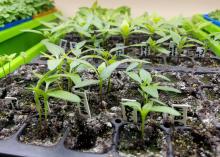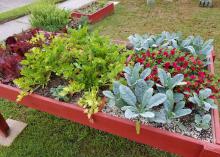Information Possibly Outdated
The information presented on this page was originally released on March 23, 2020. It may not be outdated, but please search our site for more current information. If you plan to quote or reference this information in a publication, please check with the Extension specialist or author before proceeding.
Gardening offers many stay-at-home benefits
With much of our workforce telecommuting from home and with school suspended or cancelled for the kids, cabin fever has already become an issue for many households.
Gardening is an activity everyone can take advantage of during the coming weeks to relieve the growing pressure.
One activity for the kids that can be a learning experience is planting seeds.
It’s amazing when kids -- and adults -- realize that seeds are actually living components of plants. The potential of a tiny acorn to produce a mighty oak tree always inspires me! These tiny objects have all the information required to grow a complete plant. Use quick-growing flowers like marigolds, sunflowers and zinnias to get started.
Another way to observe the power of tiny seeds and to make a delicious salad is by growing microgreens.
If you’re staying inside, growing microgreens is a perfect and easy way to garden. Microgreens grow quickly indoors with minimal effort on a windowsill or under lights. They don’t take up a lot of space, but they can have big meal-time impact.
You harvest microgreens at a young growth stage, usually cotyledon or first true leaf stage. This ranges from 7 to 21 days after germination, and microgreens will have reached approximately 1 to 3 inches tall.
Growing microgreens is a fun way to add fresh flavors along with a tender crunch to dishes. They have a variety of uses. As vegetable confetti, they add flavor, texture and color to evening meals. They can be added to salads, eaten as the salad themselves, layered on sandwiches and used as a colorful garnish.
Microgreens are rich in phytonutrients. Different varieties can have high concentrations of vitamins C and phytonutrients.
I have been growing and enjoying microgreens for more than 10 years, and they are easy for the home gardener to grow. Check out my Extension publication for growing tips, “Growing Microgreens for the Mississippi Gardener.”
Another idea I’ve often shared in group presentations is the concept of Little Free Gardens. This was an idea that originated in the Fargo, North Dakota, and Morehead, Minnesota, area with the hope of building relationships and sustainability in local neighborhoods.
Little Free Gardens are organized much like Little Free Libraries. People are encouraged to plant something, give something, take something or leave something. My wife and I established our Little Free Garden in 2018, and it is No. 146 nationally and the first in Mississippi. We grow seasonal vegetables all year. With the current situation we’re all in, we hope to share fresh herbs and vegetables with our neighbors.
Americans have always stuck together in adversity. During World War II, Victory Gardens fed our country. When the economy went into recession in 2008, interest in growing vegetable gardens rose exponentially.
We’re faced with adversity again. More gardeners putting in Little Free Gardens would increase availability of fresh food for everyone. Little Free Gardens could be called the COVID-19 Victory Garden.
Remember, the garden is not cancelled.









